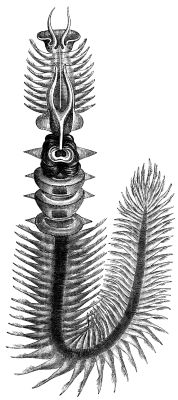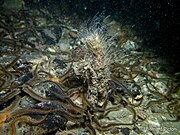50:
80:
245:
u-shaped tunnels lined with mucous, then the parchment tube, with the worm living inside the parchment tube. Each parchment tube ends with a chimney of parchment that juts above the substrate. The tubes can be as long as 85 centimeters and up to 4 centimeters in diameter at the widest portion in the buried central part of the tube. The chimneys may be wider or much narrower than the rest of the tube.
327:
are almost always present in the tubes, generally as a pair of crabs, and both species may inhabit the tubes at the same time. However, breeding pairs of either species do not share the tubes with adults of the other species. The crustaceans may live most of their lives in the tubes, leaving in the
264:
of the mid-segments of its body that are used in its specialized filter feeding regime. The worm's parapodia are modified into the shape of fans and used to create suction and pump water through the worm's parchment living tube. The morphology of the structures are used in identifying species. The
244:
The tubes the worms live in are either attached to rocks, or, more commonly, buried in sandy bottoms in shallow waters. The worm has spines along its body segments that are modified for tunneling into the sandy substrate to create the u-shaped tube within which it lives. The tubes are upright
265:
worm feeds by using modified structures on its midbody segments that create mucus nets to trap food passed through the net. A flow of water containing plankton and organic debris is created by "circular flaps" on three segments that create suction that draws water through the living tube.
281:. When the worm is disturbed in its home it moves to the end of the tube away from the disturbance and near the disturbance it emits its feeding mucus with crystals that exhibit blue luminescence.
216:-like appearance of the tubes that house these worms. Parchment tube worms are filter feeders and spend their adult lives in their tubes, unless the tube is damaged or destroyed. They are
743:
782:
328:
case of disturbance by exiting through the chimneys at either ends or, when the chimneys are too narrow, by biting through the parchment tube. A nudibranch,
398:
717:
756:
861:
615:
Living with a giant parchment tube worm: a description of a new nudibranch species (Gastropoda: Heterobranchia) associated with the annelid
33:
589:
564:
484:
382:
856:
818:
352:
is another nudibranch with similar flattened morphology which lives in muddy areas with no obvious food source, but abundant
761:
769:
604:
Haig J.(1960) The
Porcellanidae (Crustacea, Anomura) of the Eastern Pacific. Allan Hancock Pacific Expeditions 24, 1–440.
79:
678:
665:
277:
and live their entire adult lives in their buried tubes. In spite of this, known members of the genera exhibit strong
557:
Seashore animals of the
Southeast: a guide to common shallow- water invertebrates of the southeastern Atlantic Coast
425:"Larval Ontogenetic Stages of Chaetopterus: Developmental Heterochrony in the Evolution of Chaetopterid Polychaetes"
846:
787:
232:
226:
59:
402:
330:
851:
633:
315:
683:
305:
49:
348:
823:
797:
704:
530:
444:
74:
805:
748:
691:
585:
560:
480:
452:
378:
289:
Two species of filter-feeding crustaceans from different families may make their homes in the
65:
810:
522:
436:
295:
278:
124:
399:"Marine Biological Laboratory, MBL :: Marine Organisms:: Marine Organisms Database"
300:
202:
174:
157:
840:
310:
670:
696:
258:
510:
424:
774:
730:
656:
208:
worm that lives in a tube it constructs in sediments or attaches to a rocky or
261:
254:
209:
205:
137:
614:
213:
91:
456:
32:
650:
217:
147:
722:
534:
448:
338:. It is hypothesised that this nudibranch feeds on the mucus net which
221:
111:
735:
101:
627:
526:
440:
423:
Irvine, Steven Q.; Oleg Chaga; Mark W. Martindale (December 1999).
356:
tubes. It is possible that it lives and feeds in a similar manner.
198:
631:
709:
274:
511:"Changes in Abundance of the Commensal Crabs of Chaetopterus"
220:
in their juvenile forms, as is typical for polychaete
559:. Columbia, S.C: University of South Carolina Press.
224:. Species include the recently discovered deep water
640:
621:
555:Fox, Richard Wightman; Ruppert, Edward E. (1988).
613:Ekimova I., Deart Y. & Schepetov D. (2017).
582:Bioluminescence: Chemical Principles And Methods
375:Oceanography and marine biology an annual review
470:
468:
466:
8:
550:
548:
546:
544:
418:
416:
414:
412:
334:also lives within the tubes of a species of
212:substrate. The common name arises from the
628:
504:
502:
500:
498:
496:
342:uses to trap its food or on the faeces of
48:
31:
20:
475:Pleijel, Fredrik; Rouse, Greg W. (2001).
319:is known to sometimes inhabit the tubes.
377:. Washington, DC: Taylor & Francis.
584:. World Scientific Publishing Company.
365:
7:
798:d4102484-2c2e-45c3-8190-d383ee7a5442
479:. Oxford : Oxford University Press.
14:
313:) ; while a third species,
78:
253:The worms are unique among the
1:
273:Members of the genus have no
862:Taxa named by Georges Cuvier
878:
275:organs for detecting light
509:Gray, I. E. (June 1961).
233:Chaetopterus variopedatus
227:Chaetopterus pugaporcinus
75:Scientific classification
73:
60:Chaetopterus variopedatus
56:
47:
39:
30:
23:
580:Osamu Shimomura (2006).
857:Bioluminescent annelids
373:Gibson, Robin (2005).
331:Tenellia chaetopterana
316:Tumidotheres maculatus
16:Genus of annelid worms
306:Pinnixa chaetopterana
230:and the well-studied
257:worms in the highly
515:Biological Bulletin
429:Biological Bulletin
195:parchment tube worm
847:Polychaete genera
834:
833:
806:Open Tree of Life
634:Taxon identifiers
285:Commensal animals
182:
181:
178:
66:Lanice conchilega
869:
827:
826:
814:
813:
801:
800:
791:
790:
778:
777:
775:NHMSYS0021049317
765:
764:
752:
751:
739:
738:
726:
725:
713:
712:
700:
699:
687:
686:
674:
673:
661:
660:
659:
629:
622:
611:
605:
602:
596:
595:
577:
571:
570:
552:
539:
538:
506:
491:
490:
472:
461:
460:
420:
407:
406:
401:. Archived from
395:
389:
388:
370:
349:Tenellia rolleri
296:Polyonyx gibbesi
173:
83:
82:
52:
35:
21:
877:
876:
872:
871:
870:
868:
867:
866:
837:
836:
835:
830:
822:
817:
809:
804:
796:
794:
786:
781:
773:
768:
760:
755:
747:
742:
734:
729:
721:
716:
708:
703:
695:
690:
682:
677:
669:
664:
655:
654:
649:
636:
626:
625:
612:
608:
603:
599:
592:
579:
578:
574:
567:
554:
553:
542:
527:10.2307/1539537
508:
507:
494:
487:
474:
473:
464:
441:10.2307/1542786
422:
421:
410:
397:
396:
392:
385:
372:
371:
367:
362:
287:
279:bioluminescence
271:
269:Bioluminescence
251:
249:Worm morphology
242:
172:
125:Pleistoannelida
77:
17:
12:
11:
5:
875:
873:
865:
864:
859:
854:
849:
839:
838:
832:
831:
829:
828:
815:
802:
792:
779:
766:
753:
740:
727:
714:
701:
688:
675:
662:
646:
644:
638:
637:
632:
624:
623:
606:
597:
590:
572:
565:
540:
521:(3): 353–359.
492:
485:
462:
435:(3): 319–331.
408:
405:on 2008-06-10.
390:
383:
364:
363:
361:
358:
286:
283:
270:
267:
250:
247:
241:
238:
191:parchment worm
180:
179:
165:
161:
160:
158:Chaetopteridae
155:
151:
150:
145:
141:
140:
135:
128:
127:
122:
115:
114:
109:
105:
104:
99:
95:
94:
89:
85:
84:
71:
70:
54:
53:
45:
44:
37:
36:
28:
27:
15:
13:
10:
9:
6:
4:
3:
2:
874:
863:
860:
858:
855:
853:
852:Canalipalpata
850:
848:
845:
844:
842:
825:
820:
816:
812:
807:
803:
799:
793:
789:
784:
780:
776:
771:
767:
763:
758:
754:
750:
745:
741:
737:
732:
728:
724:
719:
715:
711:
706:
702:
698:
693:
689:
685:
680:
676:
672:
667:
663:
658:
652:
648:
647:
645:
643:
639:
635:
630:
620:
618:
610:
607:
601:
598:
593:
591:981-256-801-8
587:
583:
576:
573:
568:
566:0-87249-535-3
562:
558:
551:
549:
547:
545:
541:
536:
532:
528:
524:
520:
516:
512:
505:
503:
501:
499:
497:
493:
488:
486:0-19-850608-2
482:
478:
471:
469:
467:
463:
458:
454:
450:
446:
442:
438:
434:
430:
426:
419:
417:
415:
413:
409:
404:
400:
394:
391:
386:
384:0-8493-3597-3
380:
376:
369:
366:
359:
357:
355:
351:
350:
345:
341:
337:
333:
332:
326:
322:
318:
317:
312:
311:Pinnotheridae
308:
307:
302:
301:Porcellanidae
298:
297:
292:
284:
282:
280:
276:
268:
266:
263:
260:
256:
248:
246:
240:Housing tubes
239:
237:
235:
234:
229:
228:
223:
219:
215:
211:
207:
204:
200:
196:
192:
188:
187:
176:
171:
170:
166:
163:
162:
159:
156:
153:
152:
149:
146:
143:
142:
139:
136:
133:
130:
129:
126:
123:
120:
117:
116:
113:
110:
107:
106:
103:
100:
97:
96:
93:
90:
87:
86:
81:
76:
72:
68:
67:
62:
61:
55:
51:
46:
42:
38:
34:
29:
26:
22:
19:
671:Chaetopterus
642:Chaetopterus
641:
617:Chaetopterus
616:
609:
600:
581:
575:
556:
518:
514:
476:
432:
428:
403:the original
393:
374:
368:
354:Chaetopterus
353:
347:
344:Chaetopterus
343:
340:Chaetopterus
339:
336:Chaetopterus
335:
329:
324:
320:
314:
304:
294:
291:Chaetopterus
290:
288:
272:
252:
243:
231:
225:
194:
190:
186:Chaetopterus
185:
184:
183:
169:Chaetopterus
168:
167:
131:
118:
64:
58:
41:Chaetopterus
40:
25:Chaetopterus
24:
18:
731:iNaturalist
477:Polychaetes
841:Categories
360:References
255:polychaete
218:planktonic
210:coral reef
206:polychaete
138:Sedentaria
69:in front)
262:parapodia
214:parchment
98:Kingdom:
92:Eukaryota
63:(smaller
57:Photo of
657:Q5066721
651:Wikidata
457:10630333
321:Polyonyx
309:(family
299:(family
222:annelids
154:Family:
148:Spionida
112:Annelida
108:Phylum:
102:Animalia
88:Domain:
749:1359424
723:2321523
535:1539537
449:1542786
325:Pinnixa
259:derived
189:or the
164:Genus:
144:Order:
824:129229
811:466488
795:NZOR:
736:171303
588:
563:
533:
483:
455:
447:
381:
303:) and
293:tube,
203:marine
177:, 1827
175:Cuvier
819:WoRMS
762:67096
744:IRMNG
710:62151
697:84M8L
684:24832
531:JSTOR
445:JSTOR
199:genus
197:is a
132:Clade
119:Clade
788:6379
783:NCBI
757:ITIS
718:GBIF
679:BOLD
586:ISBN
561:ISBN
481:ISBN
453:PMID
379:ISBN
323:and
43:sp.
770:NBN
705:EoL
692:CoL
666:AFD
523:doi
519:120
437:doi
433:197
201:of
193:or
843::
821::
808::
785::
772::
759::
746::
733::
720::
707::
694::
681::
668::
653::
543:^
529:.
517:.
513:.
495:^
465:^
451:.
443:.
431:.
427:.
411:^
346:.
236:.
134::
121::
619:.
594:.
569:.
537:.
525::
489:.
459:.
439::
387:.
Text is available under the Creative Commons Attribution-ShareAlike License. Additional terms may apply.

